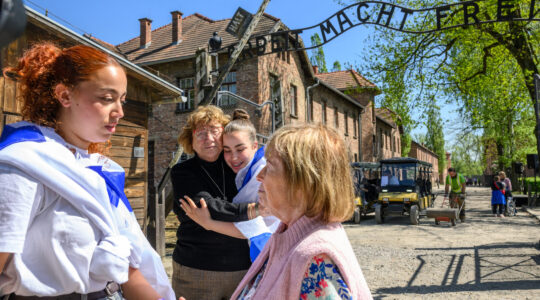
New developments jostle with buildings hundreds of years old along Kiraly Street in Budapest’s Jewish quarter. (Ben Harris)

Alexandra Kowalski, an expert in historical preservation, in front of Budapest’s Herzl Passage, a project that has enraged preservationists, Oct. 30, 2009. (Ben Harris)
BUDAPEST (JTA) — Janos Ladanyi’s eyes widened as he stepped through the narrow passage of a bar on Kazinczy Street, in the heart of this city’s old Jewish quarter.
Formerly a residential building constructed in typical Budapest fashion — several floors of apartments arranged around a rectangular open-air courtyard — Szimpla Kert is among a number of trendy new establishments that have transformed the historic neighborhood into a lively urban enclave. The courtyard is now covered, and the old residences are filled with contemporary art and a young clientele sipping cocktails and puffing on cigarettes.
As he nursed a palinka, a traditional Hungarian brandy, Ladanyi gazed admiringly at the vibrant slice of city life around him, a far cry from the disrepair in which much of the neighborhood lay just a few years before.
“I never believed I would see this trend change and I would see young people coming back here,” Ladanyi, an urban sociologist at Corvinus University in Budapest, said later over dinner at Cafe Spinoza, another establishment that has breathed new life into the quarter.
But on a post-dinner stroll through the neighborhood, as Ladanyi surveyed other changes afoot in the area, he offered a steady stream of expletives. Over the past decade, developers have knocked down scores of old buildings and built contemporary mixed-use complexes, arousing concern from both historians and preservationists, as well as the leadership of the Jewish community.
“Nowhere in the world, except in funny Third World countries, something like this is allowed,” Ladanyi said. Through decades of tyranny, “the neighborhood survived — with terrible losses, but it survived. And now we have this so-called free world, this multicultural world, and we are losing it. Isn’t that unbelievable?”
Elsewhere in Eastern Europe, rehabilitated Jewish quarters have become beloved historic districts, visited annually by thousands of tourists even as their Jewish populations have dwindled to a fraction of their prewar levels.
But in Hungary, which still boasts one of the largest Jewish communities in Europe — some 100,000 Jews live in Budapest — the Jewish quarter has fallen prey to developers that sometimes appear more intent on making a quick buck than on preserving the area’s historic character. In the process, experts say, a vital part of the capital city’s Jewish history is disappearing.
“This area lost 40 percent of its patrimony,” said Alexandra Kowalski, a lecturer in the Department of Sociology and Social Anthropology at Budapest’s Central European University and an expert on historical preservation.
Around the neighborhood, signs of the changes are everywhere. On Wesselenyi Street, the glass-sheathed Price Waterhouse Coopers office towers several floors above neighboring buildings. On Kiraly Street, the neighborhood’s main thoroughfare — old photos show an urban cacophony reminiscent of the Lower East Side or Boston’s North End — an esplanade has been constructed and new apartments and upscale boutiques now jostle for space with buildings hundreds of years old.
And next door to the famed Dohany Synagogue, Europe’s largest, construction netting hangs over the site of Herzl Passage, one of the projects that has enraged the preservationists. Construction is said to be stalled, though the project’s Web site says it is scheduled for completion in 2009.
Most of the buildings in the quarter, including its street layout, date from the early- to mid-19th century and include impressive architectural features typical of the period. The United Nations Educational, Scientific and Cultural Organization (UNESCO) has recognized part of the area a world heritage site, and several of the buildings are protected as historic landmarks by the Hungarian authorities. But activists say the measures are insufficient, and that development of the neighborhood has continued anyway.
“This special protection area was not strong enough to override the previous regulatory plan, which actually allowed in a number of demolitions and new constructions inside the district concerning the buildings which were not [specifically] protected as monuments,” said Tamas Fejerdy, the vice president of National Office of Cultural Heritage as well as the chief of the secretariat of the Hungarian National Commission for UNESCO.
Since 2004, a coalition of artists and intellectuals known as Ovas! (Veto) have been fighting to preserve the area’s historic architecture and maintain it as a healthy urban neighborhood. Leaders of the group say their concern is not merely for individual buildings, but for the urban fabric of an area that has seen many of its residents relocated elsewhere in the city.
By the time Ovas! became active, municipal authorities were saying their ability to protect properties was limited because they had already been sold off, according to Anna Perczel, the group’s current chair and one of its founders.
“The situation is quite bad,” said Perczel, an architect and the author of “Unprotected Heritage,” a 2007 book about vulnerable but historic properties in the quarter.
Though their primary targets are government agencies they claim have failed to protect the district, Ovas! reserves no small amount of scorn for the developers, many of whom happen to be Israeli. Israeli companies are said to be responsible for 60-70 percent of new real estate development in Budapest.
“I do appreciate the past and I think that there are monuments that should be preserved,” said Eliav Maimon, the CEO of Autoker, one of the largest Israeli-owned development firms active in the district. “But I don’t think the preservation should be fanatic. In many places in this city, the new developments are also creating life, not just destroying it.”
Autoker, formerly the Communist government’s automobile maintenance company, was privatized after the fall of the regime and was acquired by Israeli businessmen, who turned it into a real estate company. During the boom of the early 2000s it was considered the largest developer in Budapest, responsible for a number of large-scale projects that brought luxurious new residential complexes to the city. Maimon compared his company’s products to American-syle “gated communities.”
Transformation of the quarter began after the fall of communism, when Budapest’s cash-starved district municipalities suddenly found themselves in possession of countless valuable properties. Sales to developers began in earnest, often at rock-bottom prices. Perczel says the demolitions began in 2006.
Autoker owns several properties in the Jewish quarter, where it is planning new projects. Some of the plots already are owned by the company, which is biding its time until economic conditions improve. Maimon said Autoker’s strategy is to hold different projects in various stages of the development process in order to be prepared for any market eventuality.
By the time of Ovas! founding, Gyorgy Hunvald, the mayor of District 7, which includes the Jewish quarter, was deeply involved in selling off historic properties and allegedly making buckets of cash in the process. Hunvald was arrested in February and is now in jail facing charges of bribery and abuse of office.
Perczel sketched out a mind-bogglingly complex story of how investors, developers and the authorities in District 7 colluded to sell off properties, move people out of their homes, and tear down historic buildings for redevelopment. Some aspects of the corruption she describes border on the comical, as when a document that the district was obliged to take into account in formulating its development plan was declared secret and sealed for 15 years.
One of the properties that roused Ladanyi’s ire on a recent tour through the area was Autoker’s Gozsdu Courtyard project. In her book, Perczel says the property, which encompasses seven older buildings and six courtyards connected by a long passageway running the full length of the block, was “the pride of the Jewish quarter before the war.”
Autoker preserved the building’s appearance, as well as some interior features, according to Maimon, and the property now boasts luxurious new apartments, a swimming pool, concierge and ground-floor retail. Most of the shops are vacant.
“It’s a ghost town,” said Gyorgy Vince, 28, whose family owns a Jewish-themed bookstore in the quarter. “I am happy they are developing it, but I’m not happy it’s empty.”
In Ladanyi’s view, the developers broke a cardinal rule of urban planning: “Don’t be brutal.”
Maimon, however, says the property is vastly better than it was before — a pile of junk, in his description, the domain of junkies and homeless people. The vacancies are solely the result of the economic downturn, he said.
Fejerdy is optimistic that a new law Hungary is “in the process of producing” may pave the way for a new regulatory plan, though he asserts it must be supplemented by tax incentives and other inducements for developers to undertake projects that would balance economic interests with preservation.
Perczel says she is optimistic as well.
But Ladanyi, his eyes weary from years of battle and several glasses of wine, sees the situation as more dire.
“There is a point you are not able to turn back,” Ladanyi said. “And I think this is a neighborhood where we are very close, if not behind, that point.”
(To keep up with Ben Harris’ travels, visit blogs.jta.org/wanderingjew.)
JTA has documented Jewish history in real-time for over a century. Keep our journalism strong by joining us in supporting independent, award-winning reporting.





